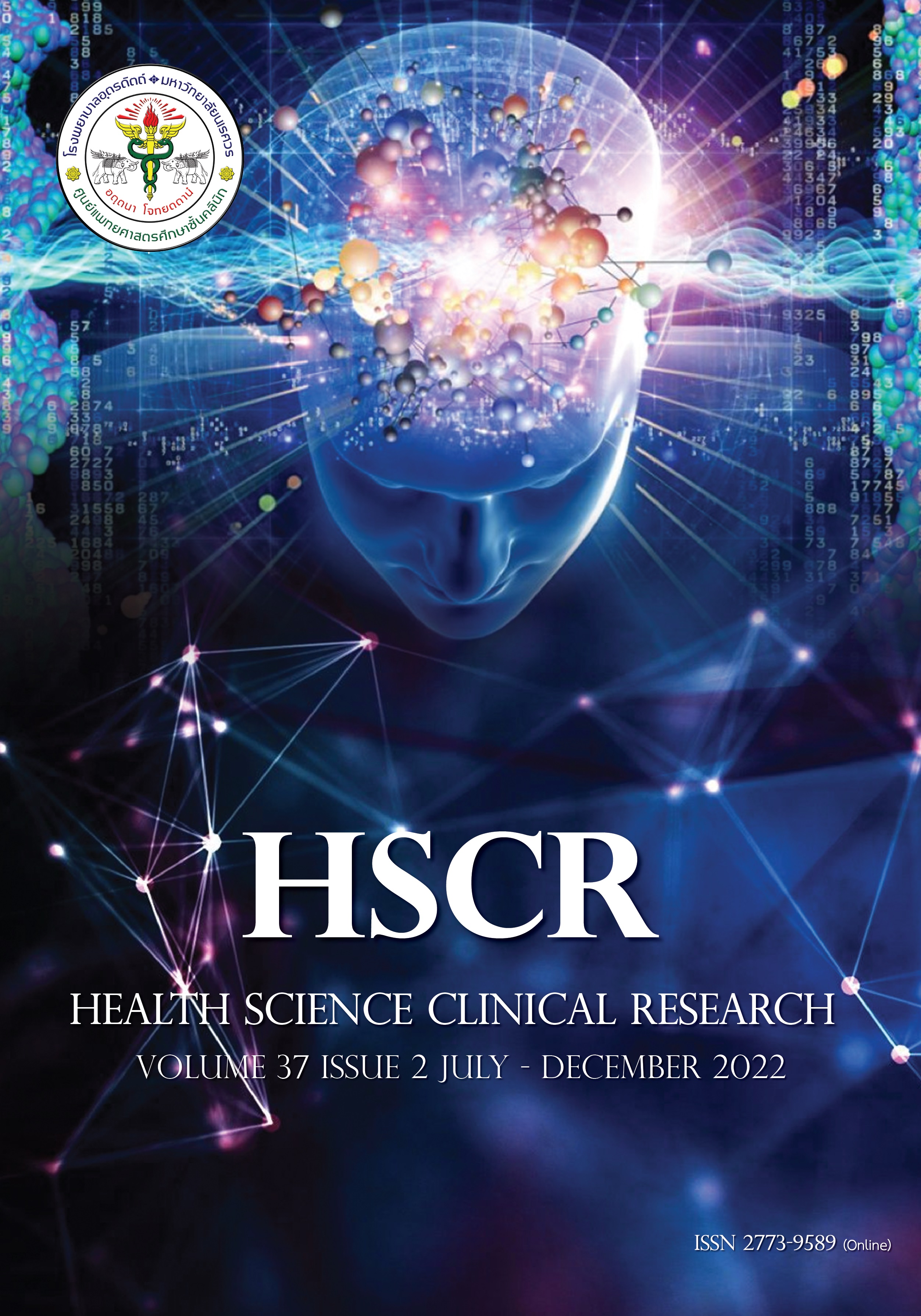The The Accuracy of Serum Prostate-Specific Antigen (PSA) Level of 4-10 ng/ml with Age and Digital Rectal Examination in Prostate Cancer Prediction
DOI:
https://doi.org/10.1016/hscr.v37i2.259633Keywords:
Accuracy, Serum Prostate-specific antigen (PSA), Prostate cancerAbstract
ABSTRACT
Objective: To study the accuracy of serum PSA level 4-10 with age and digital rectal examination in prostate cancer prediction.
Methods: From January 1st, 2017 to June 30th, 2022. The Diagnostic prediction research using a retrospective case-control study, data was collected from ICD-10 medical records from patients who were suspected to have prostate cancer and had pathologic biopsy results were studied at Uttaradit hospital. All data were analyzed by descriptive and analytic statistics.
Results: Prostate cancer prediction accuracy with serum PSA 4-10 ng/ml have sensitivity 77.5%, specificity 69.2%, positive predictive value 88.6%, negative predictive value 50.0% and AUROC 0.81 (95% CI 0.71-0.91, p=0.011). When serum PSA 4-10 ng/ml was considered in combination with age and rectal examination, sensitivity 88.9%, specificity 66.7%, positive predictive value 88.9%, Negative predictive value 66.7% increased predictive value. The occurrence of prostate cancer was AUROC 0.93 (95% CI 0.84-1.00, p<0.001)
Conclusion: In this study, the accuracy in prostate cancer prediction, Serum PSA alone is not appropriate for the diagnosis of prostate cancer. If serum PSA 4-10 ng/ml was considered with age and digital rectal examination, it should be more accurate in predicting the incidence of prostate cancer
Keywords: Accuracy, Serum Prostate-specific antigen (PSA), Rectal examination, Prostate cancer
References
Rawla P. Epidemiology of Prostate Cancer. World J Oncol. 2019 Apr;10(2):63–89.
Gann PH. Risk Factors for Prostate Cancer. Rev Urol. 2002;4(Suppl 5):S3–10.
Hamilton W, Sharp DJ, Peters TJ, Round AP. Clinical features of prostate cancer before diagnosis: a population-based, case-control study. Br J Gen Pract. 2006 Oct 1;56(531):756–62.
ไชยยงค์ นวลยง. มะเร็งต่อมลูกหมาก [Internet]. คณะแพทยศาสตร์ศิริราชพยาบาล; 2553 [cited 2022 Jul 18]. Available from: https://www.si.mahidol.ac.th/sidoctor/epl/admin/article_files /571_1.pdf
Liu J, Wang ZQ, Li M, Zhou MY, Yu YF, Zhan WW. Establishment of two new predictive models for prostate cancer to determine whether to require prostate biopsy when the PSA level is in the diagnostic gray zone (4–10 ng ml−1). Asian J Androl. 2019 Jun 4;22(2):213–6.
Mello-Grand M, Bruno A, Sacchetto L, Cristoni S, Gregnanin I, Dematteis A, et al. Two Novel Ceramide-Like Molecules and miR-5100 Levels as Biomarkers Improve Prediction of Prostate Cancer in Gray-Zone PSA. Front Oncol. 2021 Nov 19;11:769158.
Tritipwanit S, Chotikawanich E, Nualyong C, Leewansangtong S, Taweemonkongsap T, Phinthusophon K. Diagnostic Accuracy of BMI and PSA Density in Screening Prostate Cancer Patients in the PSA Diagnostic Gray Zone (4-10 ng/ml). Insight Urol. 2015 Dec 1;36(2):1–10.
Lee J, Yang SW, Jin L, Lee CL, Lee JY, Shin JH, et al. Is PSA density of the peripheral zone as a useful predictor for prostate cancer in patients with gray zone PSA levels? BMC Cancer. 2021 Dec;21(1):472.
สุทธิพร จิตต์มิตรภาพ. ตำราศัลยศาสตร์. พิมพ์ครั้งที่ 12. กรุงเทพฯ: คณะแพทยศาสตร์ จุฬาลงกรณ์มหาวิทยาลัย; 2558.
Udomphot C, Lojanapiwat B, Jun-U J. PSA Level and Result of Prostate Biopsy in 10 Years in Maharaj Nakorn Chiang Mai Hospital. Insight Urol. 2012 Jun 1;33(1):9–15.
Michael J. Duffyb Andrew W. Roddama, Freddie C. Hamdy. Use of Prostate-Specific Antigen (PSA) Isoforms
for the Detection of Prostate Cancer in Men with a PSA Level of 2–10 ng/ml: Systematic Review and Meta-Analysis. 2005 [cited 2022 Jul 18]. Available from: https://pubmed.ncbi.nlm.nih.gov/15982797/
พัชรภรณ์ ทองวัชระ, อนงนาฏ เรืองดำ . มะเร็งต่อมลูกหมาก. 2556 [cited 2565 Jul 14];. Available from: http://hocc.medicine.psu.ac.th/files/khowledge/5_56.pdf.
Descotes Jean-Luc. Diagnosis of prostate cancer. Asian J Urol. 2019 Apr;6(2):129–36.
Sadi MV. PSA screening for prostate cancer. Rev Assoc Medica Bras 1992. 2017 Aug;63(8):722–5.
ศูนย์มะเร็งตรงเป้า. มะเร็งต่อมลูกหมาก และการคัดกรอง: ข้อบ่งชี้ ค่าPSA และการแปลผล [Internet]. 2019 [cited 2022 Jul 18]. Available from: https://www.chularatcancercenter.com/th/คัด-มะเร็งต่อมลูกหมาก
พีรพัฒน์ ชีวะอิสระกุล. ความสัมพันธ์ของระดับโปรสเตทสเปซิฟิกแอนติเจนและมะเร็งต่อมลูกหมาก: การศึกษาแบบย้อนหลัง วิเคราะห์จากเหตุไปหาผล. วารสารแพทย์เขต 4-5. 2022 Jun 30;41(2):111–21.
Zheng Z, Zhou Z, Yan W, Zhou Y, Chen C, Li H, et al. Tumor characteristics, treatments, and survival outcomes in prostate cancer patients with a PSA level < 4ng/ml: a population-based study. BMC Cancer. 2020 Apr 22;20:340.
Sawangsupakul W. Early Detection of Prostate Cancer Using Serum PSA Level and/or Digital Rectal Examination in Chaoprayayomrat Hospital, Suphanburi. Region 4-5 Medical Journal. 2009;28(1):29–34.
Kittinukulkit A, Kanjanapayak B, Chaypan N, Lamthong S, Reungpoka P, Pangkul A. Prostate-specific antigen (PSA) cutoff for improves clinical judgment before the decision to repeat prostate biopsy. Insight Urol. 2008 Jun 1;29(1):13–9.
ไพจิตรวิเชียร ส. ความสามารถในการวินิจฉัยมะเร็งต่อมลูกหมาก ของระดับค่า Prostate-Specific Antigen ในโรงพยาบาลนครพิงค์. ลำปางเวชสาร 2015 Dec 30;36(2):54–63.
Liu ZY, Sun YH, Xu CL, Gao X, Zhang LM, Ren SC. Age-specific PSA reference ranges in Chinese men without prostate cancer. Asian J Androl. 2009 Jan;11(1):100–3.
Li Y, Han D, Wu P, Ren J, Ma S, Zhang J, et al. Comparison of 68Ga-PSMA-617 PET/CT with mpMRI for the detection of PCa in patients with a PSA level of 4-20 ng/ml before the initial biopsy. Scientific Reports. 2020 Jul 3;10(1):10963.
Yin H, Shao J, Song H, Ding W, Xu B, Cao H, et al. MRI Screening and MRI/US Fusion-Guided Transperineal Biopsy in Detecting Prostate Cancer. Technol Cancer Res Treat. 2021 May 20;20:15330338211019418.
Thompson IM, Pauler DK, Goodman PJ, Tangen CM, Lucia MS, Parnes HL, et al. Prevalence of prostate cancer among men with a prostate-specific antigen level < or =4.0 ng per milliliter. N Engl J Med. 2004 May 27;350(22):2239–46.
Chen M, Ma T, Li J, Zhang HJ, Li Q, Wang JJ, et al. Diagnosis of Prostate Cancer in Patients with Prostate-Specific Antigen (PSA) in the Gray Area: Construction of 2 Predictive Models. Med Sci Monit Int Med J Exp Clin Res. 2021 Feb 8;27:e929913.
Hoffman RM, Gilliland FD, Adams-Cameron M, Hunt WC, Key CR. Prostate-specific antigen testing accuracy in community practice. BMC Fam Pract. 2002 Dec;3(1):19.
Mubenga LE, Hermans MP, Chimanuka D, Muhindo L, Bwenge E, Tombal B. Prostate volume and its relationship with anthropometric variables among different ethnic groups of South-Kivu, DR Congo. Afr J Urol. 2020 Dec;26(1):32.
Saema A, Kochakarn W, Lertsithichai P. PSA Density and Prostate Cancer Detection. 2012;95(5):6.
Sangprachathanarak P, Leewansangtong S, Ratanarapee S, Tantiwong A, Nualyong C, Taweemankongsap T, et al. Risk of Prostate Cancer Detection in Thai Men with Abnormal PSA Testing. Insight Urol. 2006 Jun 1;27(1):26–9.
Yeniyol CO, Bozkaya G, Cavuşoğlu A, Arslan M, Karaca B, Ayder AR. The relation of prostate biopsy results and ratio of free to total PSA in patients with a total PSA between 4-20 ng/mL. Int Urol Nephrol. 2001;33(3):503–6.
Zhou Y, Li Y, Li X, Jiang M. Urinary Biomarker Panel to Improve Accuracy in Predicting Prostate Biopsy Result in Chinese Men with PSA 4–10ng/mL. BioMed Res Int. 2017;2017:2512536.
Roddam AW, Duffy MJ, Hamdy FC, Ward AM, Patnick J, Price CP, et al. Use of Prostate-Specific Antigen (PSA) Isoforms for the Detection of Prostate Cancer in Men with a PSA Level of 2–10 ng/ml: Systematic Review and Meta-Analysis. Eur Urol. 2005 Sep 1;48(3):386–99.(19–32)
วนิดา ผาตาล. ค่าความไวและค่าความจำเพาะของSerum Prostate specific antigen เมื่อเทียบกับการตรวจทางศัลยพยาธิวิทยาในมะเร็งต่อมลูกหมากในโรงพยาบาลอุดรธานี. 2564.
Downloads
Published
How to Cite
Issue
Section
License
Copyright (c) 2022 Health Science Clinical Research

This work is licensed under a Creative Commons Attribution-NonCommercial-NoDerivatives 4.0 International License.
The names and email addresses entered in this journal site will be used exclusively for the stated purposes of this journal and will not be made available for any other purpose or to any other party.















